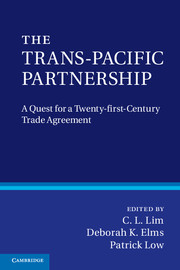Book contents
- Frontmatter
- Contents
- List of Figures and Tables
- Contributors
- Preface
- Acknowledgements
- Disclaimer
- Glossary
- Part I Introduction
- Part II The past: origins of the TPP Agreement
- Part III The present: twenty-first century elements and obstacles
- 6 Negotiations over market access in goods
- 7 TPP negotiations
- 8 Trade in services
- 9 TPP Agreement
- 10 The intellectual property chapter in the TPP
- 11 Regulatory coherence in the TPP talks
- 12 Environmental issues in the TPP
- 13 Labour standards and the TPP
- 14 What is to be done with export restrictions?
- Part IV The future: high-quality meets regional and global realities
- Part V The TPP negotiations: the quest for quality
- Index
- References
10 - The intellectual property chapter in the TPP
Published online by Cambridge University Press: 05 November 2012
- Frontmatter
- Contents
- List of Figures and Tables
- Contributors
- Preface
- Acknowledgements
- Disclaimer
- Glossary
- Part I Introduction
- Part II The past: origins of the TPP Agreement
- Part III The present: twenty-first century elements and obstacles
- 6 Negotiations over market access in goods
- 7 TPP negotiations
- 8 Trade in services
- 9 TPP Agreement
- 10 The intellectual property chapter in the TPP
- 11 Regulatory coherence in the TPP talks
- 12 Environmental issues in the TPP
- 13 Labour standards and the TPP
- 14 What is to be done with export restrictions?
- Part IV The future: high-quality meets regional and global realities
- Part V The TPP negotiations: the quest for quality
- Index
- References
Summary
Introduction
All intellectual property can function as a form of trade barrier, because intellectual property rights can be used to prevent imports of goods or services. However, because intellectual property can also be welfare enhancing, TRIPS recognizes that some intellectual property protection is consistent with liberalizing trade. However, too much intellectual property protection is almost never trade enhancing, it is protectionist. Since TRIPS came into force, the ratcheting-up of intellectual property norms, through preferential trade agreements (PTAs), has been controversial. The potential scope of the intellectual property chapter in the TPP is even more controversial. At the core of the controversy are the leaked texts of the US proposal, which seeks a level of intellectual property protection that is much more extensive than TRIPS, and even more extensive than other intellectual property chapters in PTAs to which the US is a party, such as AUSFTA and KORUS.
In contrast to the US proposal, the Chilean and the New Zealand proposed texts, which were also leaked, call for an affirmation of the TRIPS Agreement standards. Those texts also propose a better articulation of the availability of intellectual property exceptions and flexibilities. The New Zealand text also proposes certain protections of traditional knowledge and a more detailed articulation of the objectives and purposes of intellectual property protection in a trade-related setting. Peru supports greater protection of traditional knowledge and biological and genetic resources.
- Type
- Chapter
- Information
- The Trans-Pacific PartnershipA Quest for a Twenty-first Century Trade Agreement, pp. 157 - 170Publisher: Cambridge University PressPrint publication year: 2012
References
- 4
- Cited by



